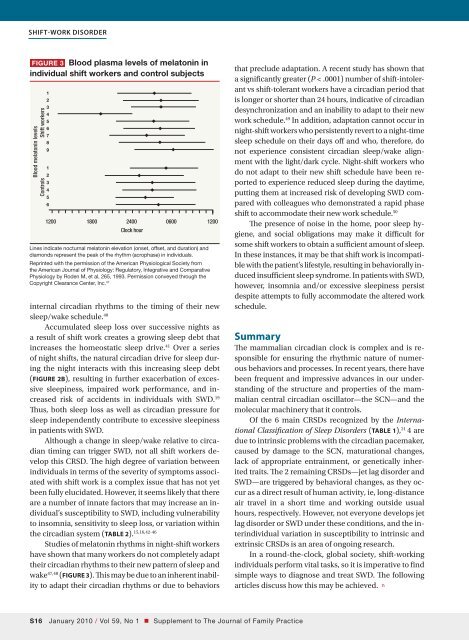Shift-work disorder - myCME.com
Shift-work disorder - myCME.com
Shift-work disorder - myCME.com
You also want an ePaper? Increase the reach of your titles
YUMPU automatically turns print PDFs into web optimized ePapers that Google loves.
<strong>Shift</strong>-<strong>work</strong> <strong>disorder</strong><br />
Figure 3 Blood plasma levels of melatonin in<br />
individual shift <strong>work</strong>ers and control subjects<br />
Blood melatonin levels<br />
<strong>Shift</strong> <strong>work</strong>ers<br />
Controls<br />
1<br />
2<br />
3<br />
4<br />
5<br />
6<br />
7<br />
8<br />
9<br />
1<br />
2<br />
3<br />
4<br />
5<br />
6<br />
1200 1800 2400 0600 1200<br />
Clock hour<br />
Lines indicate nocturnal melatonin elevation (onset, offset, and duration) and<br />
diamonds represent the peak of the rhythm (acrophase) in individuals.<br />
Reprinted with the permission of the American Physiological Society from<br />
the American Journal of Physiology: Regulatory, Integrative and Comparative<br />
Physiology by Roden M, et al, 265, 1993. Permission conveyed through the<br />
Copyright Clearance Center, Inc. 47<br />
internal circadian rhythms to the timing of their new<br />
sleep/wake schedule. 40<br />
Accumulated sleep loss over successive nights as<br />
a result of shift <strong>work</strong> creates a growing sleep debt that<br />
increases the homeostatic sleep drive. 41 Over a series<br />
of night shifts, the natural circadian drive for sleep during<br />
the night interacts with this increasing sleep debt<br />
(FIGURE 2B), resulting in further exacerbation of excessive<br />
sleepiness, impaired <strong>work</strong> performance, and increased<br />
risk of accidents in individuals with SWD. 19<br />
Thus, both sleep loss as well as circadian pressure for<br />
sleep independently contribute to excessive sleepiness<br />
in patients with SWD.<br />
Although a change in sleep/wake relative to circadian<br />
timing can trigger SWD, not all shift <strong>work</strong>ers develop<br />
this CRSD. The high degree of variation between<br />
individuals in terms of the severity of symptoms associated<br />
with shift <strong>work</strong> is a <strong>com</strong>plex issue that has not yet<br />
been fully elucidated. However, it seems likely that there<br />
are a number of innate factors that may increase an individual’s<br />
susceptibility to SWD, including vulnerability<br />
to insomnia, sensitivity to sleep loss, or variation within<br />
the circadian system (TABLE 2). 15,16,42-46<br />
Studies of melatonin rhythms in night-shift <strong>work</strong>ers<br />
have shown that many <strong>work</strong>ers do not <strong>com</strong>pletely adapt<br />
their circadian rhythms to their new pattern of sleep and<br />
wake 47,48 (FIGURE 3). This may be due to an inherent inability<br />
to adapt their circadian rhythms or due to behaviors<br />
that preclude adaptation. A recent study has shown that<br />
a significantly greater (P < .0001) number of shift-intolerant<br />
vs shift-tolerant <strong>work</strong>ers have a circadian period that<br />
is longer or shorter than 24 hours, indicative of circadian<br />
desynchronization and an inability to adapt to their new<br />
<strong>work</strong> schedule. 49 In addition, adaptation cannot occur in<br />
night-shift <strong>work</strong>ers who persistently revert to a night-time<br />
sleep schedule on their days off and who, therefore, do<br />
not experience consistent circadian sleep/wake alignment<br />
with the light/dark cycle. Night-shift <strong>work</strong>ers who<br />
do not adapt to their new shift schedule have been reported<br />
to experience reduced sleep during the daytime,<br />
putting them at increased risk of developing SWD <strong>com</strong>pared<br />
with colleagues who demonstrated a rapid phase<br />
shift to ac<strong>com</strong>modate their new <strong>work</strong> schedule. 50<br />
The presence of noise in the home, poor sleep hygiene,<br />
and social obligations may make it difficult for<br />
some shift <strong>work</strong>ers to obtain a sufficient amount of sleep.<br />
In these instances, it may be that shift <strong>work</strong> is in<strong>com</strong>patible<br />
with the patient’s lifestyle, resulting in behaviorally induced<br />
insufficient sleep syndrome. In patients with SWD,<br />
however, insomnia and/or excessive sleepiness persist<br />
despite attempts to fully ac<strong>com</strong>modate the altered <strong>work</strong><br />
schedule.<br />
Summary<br />
The mammalian circadian clock is <strong>com</strong>plex and is responsible<br />
for ensuring the rhythmic nature of numerous<br />
behaviors and processes. In recent years, there have<br />
been frequent and impressive advances in our understanding<br />
of the structure and properties of the mammalian<br />
central circadian oscillator—the SCN—and the<br />
molecular machinery that it controls.<br />
Of the 6 main CRSDs recognized by the International<br />
Classification of Sleep Disorders (TABLE 1), 21 4 are<br />
due to intrinsic problems with the circadian pacemaker,<br />
caused by damage to the SCN, maturational changes,<br />
lack of appropriate entrainment, or genetically inherited<br />
traits. The 2 remaining CRSDs—jet lag <strong>disorder</strong> and<br />
SWD—are triggered by behavioral changes, as they occur<br />
as a direct result of human activity, ie, long-distance<br />
air travel in a short time and <strong>work</strong>ing outside usual<br />
hours, respectively. However, not everyone develops jet<br />
lag <strong>disorder</strong> or SWD under these conditions, and the interindividual<br />
variation in susceptibility to intrinsic and<br />
extrinsic CRSDs is an area of ongoing research.<br />
In a round-the-clock, global society, shift-<strong>work</strong>ing<br />
individuals perform vital tasks, so it is imperative to find<br />
simple ways to diagnose and treat SWD. The following<br />
articles discuss how this may be achieved. n<br />
S16 January 2010 / Vol 59, No 1 • Supplement to The Journal of Family Practice
















